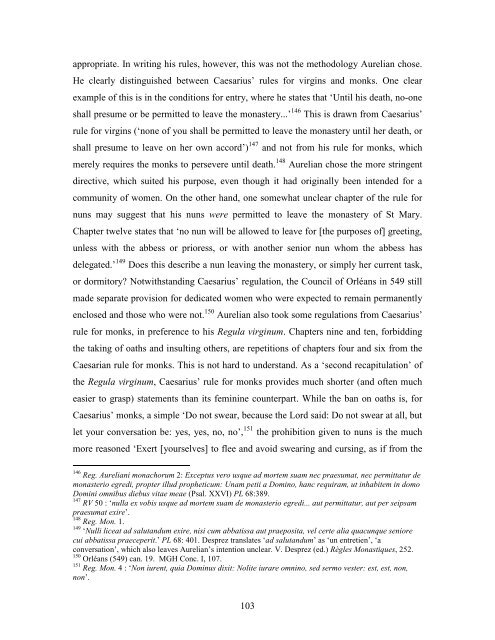Lindsay Rudge PhD Thesis - University of St Andrews
Lindsay Rudge PhD Thesis - University of St Andrews
Lindsay Rudge PhD Thesis - University of St Andrews
Create successful ePaper yourself
Turn your PDF publications into a flip-book with our unique Google optimized e-Paper software.
appropriate. In writing his rules, however, this was not the methodology Aurelian chose.<br />
He clearly distinguished between Caesarius’ rules for virgins and monks. One clear<br />
example <strong>of</strong> this is in the conditions for entry, where he states that ‘Until his death, no-one<br />
shall presume or be permitted to leave the monastery...’ 146 This is drawn from Caesarius’<br />
rule for virgins (‘none <strong>of</strong> you shall be permitted to leave the monastery until her death, or<br />
shall presume to leave on her own accord’) 147 and not from his rule for monks, which<br />
merely requires the monks to persevere until death. 148 Aurelian chose the more stringent<br />
directive, which suited his purpose, even though it had originally been intended for a<br />
community <strong>of</strong> women. On the other hand, one somewhat unclear chapter <strong>of</strong> the rule for<br />
nuns may suggest that his nuns were permitted to leave the monastery <strong>of</strong> <strong>St</strong> Mary.<br />
Chapter twelve states that ‘no nun will be allowed to leave for [the purposes <strong>of</strong>] greeting,<br />
unless with the abbess or prioress, or with another senior nun whom the abbess has<br />
delegated.’ 149 Does this describe a nun leaving the monastery, or simply her current task,<br />
or dormitory? Notwithstanding Caesarius’ regulation, the Council <strong>of</strong> Orléans in 549 still<br />
made separate provision for dedicated women who were expected to remain permanently<br />
enclosed and those who were not. 150 Aurelian also took some regulations from Caesarius’<br />
rule for monks, in preference to his Regula virginum. Chapters nine and ten, forbidding<br />
the taking <strong>of</strong> oaths and insulting others, are repetitions <strong>of</strong> chapters four and six from the<br />
Caesarian rule for monks. This is not hard to understand. As a ‘second recapitulation’ <strong>of</strong><br />
the Regula virginum, Caesarius’ rule for monks provides much shorter (and <strong>of</strong>ten much<br />
easier to grasp) statements than its feminine counterpart. While the ban on oaths is, for<br />
Caesarius’ monks, a simple ‘Do not swear, because the Lord said: Do not swear at all, but<br />
let your conversation be: yes, yes, no, no’, 151 the prohibition given to nuns is the much<br />
more reasoned ‘Exert [yourselves] to flee and avoid swearing and cursing, as if from the<br />
146<br />
Reg. Aureliani monachorum 2: Exceptus vero usque ad mortem suam nec praesumat, nec permittatur de<br />
monasterio egredi, propter illud propheticum: Unam petii a Domino, hanc requiram, ut inhabitem in domo<br />
Domini omnibus diebus vitae meae (Psal. XXVI) PL 68:389.<br />
147<br />
RV 50 : ‘nulla ex vobis usque ad mortem suam de monasterio egredi... aut permittatur, aut per seipsam<br />
praesumat exire’.<br />
148<br />
Reg. Mon. 1.<br />
149<br />
‘Nulli liceat ad salutandum exire, nisi cum abbatissa aut praeposita, vel certe alia quacunque seniore<br />
cui abbatissa praeceperit.’ PL 68: 401. Desprez translates ‘ad salutandum’ as ‘un entretien’, ‘a<br />
conversation’, which also leaves Aurelian’s intention unclear. V. Desprez (ed.) Règles Monastiques, 252.<br />
150<br />
Orléans (549) can. 19. MGH Conc. I, 107.<br />
151<br />
Reg. Mon. 4 : ‘Non iurent, quia Dominus dixit: Nolite iurare omnino, sed sermo vester: est, est, non,<br />
non’.<br />
103

















